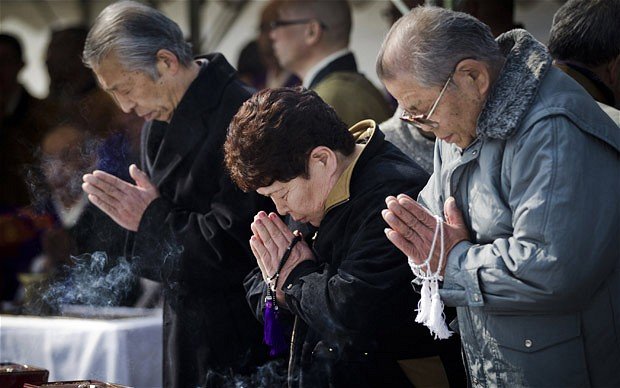
Japan marks one year commemoration of the devastating earthquake and tsunami, which struck the north-eastern coast, leaving 20,000 dead or missing.
The 9-magnitude quake, Japan’s most powerful since records began, also triggered a serious nuclear accident at the Fukushima Daiichi nuclear plant.
Thousands of people were evacuated as radiation leaked from the plant.
There were memorial services, and a minute’s silence was observed at the moment the quake hit, 14:46 local time.
The main memorial ceremony was held at Tokyo’s National Theatre, attended by Japan’s Emperor Akihito, Empress Michiko and Prime Minister Yoshihiko Noda.
“We shall not let our memory of the disasters fade,” Emperor Akihito said in a brief televised address.
“I hope all the people will keep the victims in their hearts.”
PM Yoshihiko Noda pledged to rebuild so that Japan could be reborn “as an even better place”.

Much of Japan came to a standstill as the minute of silence was observed.
Warning sirens sounded across the north-east of the country at the precise time the quake struck, 14:46 local time. Bells and prayers also reverberated across the country.
The earthquake struck about 400 km (250 miles) north-east of Tokyo on 11 March 2011.
Shortly after the quake, an immense surge of water enveloped the north-eastern coast as a tsunami swept cars, ships, and buildings away, crushing coastal communities.
The twin natural disasters claimed more than 15,800 lives, and more than 3,000 people remain unaccounted for.
In the Fukushima prefecture, where the Fukushima Daiichi nuclear plant is located, the impact of the disaster was particularly acute.
Radiation leaked from the plant after a series of fires and explosions damaged four of the plant’s six reactor buildings, with serious failures in the plant’s cooling system being at the heart of the problem.
A 20 km (12.5 mile) exclusion zone around the plant was put in place making tens of thousands of people homeless. Radiation means the area around remains uninhabitable.
The plant is in cold shutdown now and PM Yoshihiko Noda has promised that over the decades to come it will be decommissioned. He has also pledged to rebuild the devastated towns along the coast.
However, Japan is still dealing with the economic and political fallout of the disaster. Japan’s prime minister at the time of the disaster, Naoto Kan, resigned months later.
Naoto Kan had been criticized for failing to show leadership during the nuclear crisis after the quake. The nuclear crisis also revealed serious flaws in the nuclear industry’s regulatory systems and safety standards.
Although much of the debris has been cleared, survivors from the devastated north-east have complained about slow recovery efforts.
[youtube LPDUC08lG_Y]
[youtube M0pm_AxAtLY]